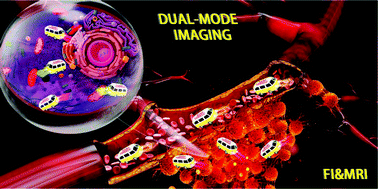Multifunctional gold nanoparticles as smart nanovehicles with enhanced tumour-targeting abilities for intracellular pH mapping and in vivo MR/fluorescence imaging†
Abstract
A number of multimodal agents have been developed for tumour imaging and diagnosis, but most of them cannot be used to study the detailed physiological or pathological changes in living cells at the same time. Herein, a series of pH-responsive magnetic resonance and fluorescence imaging (MRI/FI) dual-modal “nanovehicles” are developed and tested. These new dual-modal materials allow for intercellular pH sensing, and those with units that are dually sensitive towards both acidic and basic environments have the ability for intracellular pH mapping and can be used to quantify pH at the cellular level. In addition, detailed pH changes in organelles (including lysosomes and mitochondria) can be investigated at the same time. On the other hand, with the tumour-targeting peptide (cRGD)-modified dual-modal nanovehicles, in vivo tumour MR and fluorescence imaging, which is suitable for cancer diagnosis, can be achieved. Moreover, it has been proved that these materials can pass through the blood brain barrier (BBB). By combining the above mentioned promising properties, these novel multifunctional “nanovehicles” may provide a new method for studying the role of pH during cancer diagnosis and treatment.



 Please wait while we load your content...
Please wait while we load your content...